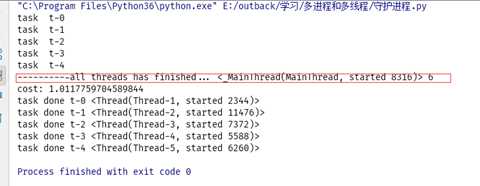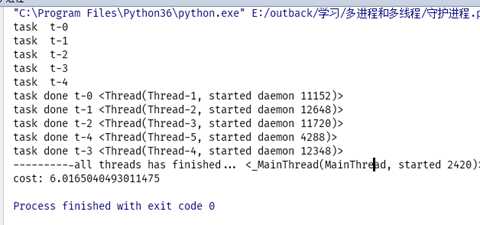起线程
以函数的方式以一个线程
mport threading
import time
def run(n):
print("task ",n )
time.sleep(2)
print("task done",n)
start_time = time.time()
t_objs = [] #存线程实例
for i in range(10):
t = threading.Thread(target=run,args=("t-%s" %i ,)) #起线程
t.start()
t_objs.append(t) #为了不阻塞后面线程的启动,不在这里join,先放到一个列表里
for t in t_objs: #循环线程实例列表,等待所有线程执行完毕
t.join()
print("----------all threads has finished...")
print("cost:",time.time() - start_time)
测试时间略大于2秒. 主线程和这个主线程所启动的子线程是并行的,主线程的执行和子线程无关,要想在程序中让主线程等待子线程 的执行,只能加join() 方法.
以类的方式以线程
|
import threading import time
class MyThread(threading.Thread): def __init__(self,n,sleep_time): super(MyThread,self).__init__() self.n = n self.sleep_time = sleep_time def run(self): # 重写父类的run 函数,所以只能是这个函数名 print("runnint task ",self.n ) time.sleep(self.sleep_time) print("task done,",self.n )
t1 = MyThread("t1",2) t2 = MyThread("t2",4)
t1.start() t2.start()
t1.join() t2.join() # 写上这两句之后,先把t1和t2执行完之后再执行print("main thread...."),不然就是先执行print("main thread....")
守护线程
如果没有设置守护线程,
可以看出,是先把print 语句执行完之后,程序再等待执行所有子线程执行完的,
加上守护线程之后的结果
程序没有等待子线程执行完之后就退出了.
把join() 加上之后(也就是把那两行代码的注释取消之后)的结果:
主要是比较他们执行的顺序.
线程锁 import threading import time
def run(n): lock.acquire() # 加锁, global num num += 1 time.sleep(0.2) lock.release() # 解锁
lock = threading.Lock() # 生成一个线程锁实例 num = 0 t_objs = [] # 存线程实例 for i in range(5): t = threading.Thread(target=run, args=("t-%s" % i,)) t.start() t_objs.append(t) # 为了不阻塞后面线程的启动,不在这里join,先放到一个列表里
for t in t_objs: # 循环线程实例列表,等待所有线程执行完毕 t.join()
print("all threads has finished :", threading.current_thread(), threading.active_count())
print("num:", num)
加锁之后,在锁中间部分程序就是串行了,Python3中解释器自动加锁了,所以可以不再加锁, 递归锁
信号量
事件Event import time import threading
event = threading.Event()
def lighter(): count = 0 event.set() #先设置绿灯 while True: if count >5 and count < 10: #改成红灯 event.clear() #把标志位清了 print("\033[41;1mred light is on....\033[0m") elif count >10: event.set() #变绿灯 count = 0 else: print("\033[42;1mgreen light is on....\033[0m") time.sleep(1) count +=1
def car(name): while True: if event.is_set(): #代表绿灯 print("[%s] running..."% name ) time.sleep(1) else: print("[%s] sees red light , waiting...." %name) event.wait() print("\033[34;1m[%s] green light is on, start going...\033[0m" %name)
light = threading.Thread(target=lighter,) light.start()
car1 = threading.Thread(target=car,args=("Tesla",)) car1.start()
事件程序只有三种状态,set(), wait(),clear(),可以在这三种状态下分别做事情, 线程队列 # 生产者消费者模型 import threading,time
import queue
q = queue.Queue(maxsize=10) # 定义一个共用的线程queue
def Producer(name): count = 1 while True: q.put("包子%s" % count) print("生产了包子",count) count +=1 time.sleep(0.5)
def Consumer(name): #while q.qsize()>0: while True: print("[%s] 取到[%s] 并且吃了它..." %(name, q.get())) time.sleep(1)
p = threading.Thread(target=Producer,args=("zhangsan",)) c = threading.Thread(target=Consumer,args=("lishi",)) c1 = threading.Thread(target=Consumer,args=("wangwu",))
p.start() c.start() c1.start()
|



